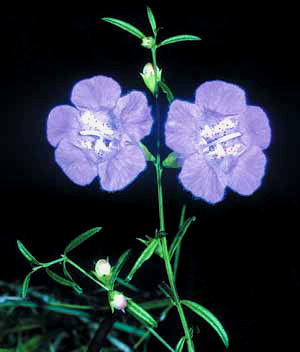False-foxglove, also called gerardia, is any of a number of plants that live on other plants. Scientists refer to false-foxgloves as root parasites. These plants have specialized roots that attach themselves to the roots of other plants, taking water and nutrients (nourishing substances) from the host plant’s roots. False-foxgloves grow in North and South America. They get their name from their resemblance to true foxgloves, another group of plants.

Most false-foxgloves are annuals, or plants that live for one growing season, though some are perennials, which live for more than two growing seasons. False-foxgloves typically grow 12 to 48 inches (30 to 122 centimeters) high. They have long, thin leaves and bell-shaped or funnel-shaped flowers. The flowers are pink or purple in color, usually marked with yellow lines. A common kind of false-foxglove, the purple false-foxglove, grows throughout much of North America.
Gardeners often sow false-foxgloves in early spring. The plants can grow in a variety of soils.
